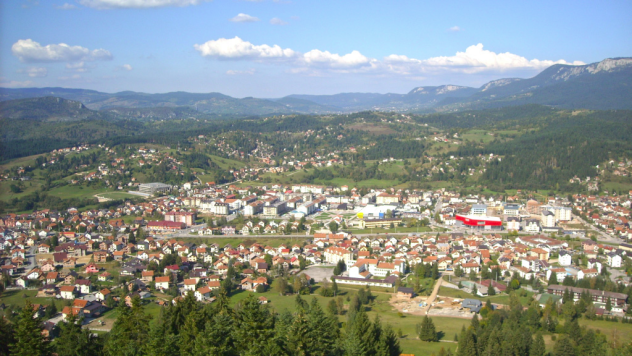 Weird Stuff
Weird Stuff  Weird Stuff
Weird Stuff  Mysteries
Mysteries 10 Tragic Disappearances and Deaths in Joshua Tree National Park
 History
History 10 Ways Childhood Really Sucked in the Old West
 Music
Music 10 Name Origins of Famous Bands from the 1990s
 Religion
Religion 10 Biggest Turnarounds by the Catholic Church
 Weird Stuff
Weird Stuff 10 Unbelievable Times Laws Had Unintended Consequences
 Humans
Humans Ten Historic Women Who Deserve Way More Credit Than They Got
 Movies and TV
Movies and TV 10 Films That Spawned Major Lawsuits
 History
History Ten Times Towns Were Wiped Off the Face of the Earth
 Creepy
Creepy 10 of the Most Disturbingly Haunted Public Houses in the UK
 Weird Stuff
Weird Stuff 10 Niche Subcultures That Are More Popular Than You Might Think
 Mysteries
Mysteries 10 Tragic Disappearances and Deaths in Joshua Tree National Park
 History
History 10 Ways Childhood Really Sucked in the Old West
Who's Behind Listverse?

Jamie Frater
Head Editor
Jamie founded Listverse due to an insatiable desire to share fascinating, obscure, and bizarre facts. He has been a guest speaker on numerous national radio and television stations and is a five time published author.
More About Us Music
Music 10 Name Origins of Famous Bands from the 1990s
 Religion
Religion 10 Biggest Turnarounds by the Catholic Church
 Weird Stuff
Weird Stuff 10 Unbelievable Times Laws Had Unintended Consequences
 Humans
Humans Ten Historic Women Who Deserve Way More Credit Than They Got
 Movies and TV
Movies and TV 10 Films That Spawned Major Lawsuits
 History
History Ten Times Towns Were Wiped Off the Face of the Earth
 Creepy
Creepy 10 of the Most Disturbingly Haunted Public Houses in the UK
10 Dark Tales From The Hunt For Bosnia’s Worst War Criminal
Charlie Chaplin once said, “Life is a tragedy when seen in close up, but a comedy in long shot.” No matter how dark or horrifying something may be, the basic absurdity of human existence will always shine through. Such was the case with the hunt for Bosnian-Serb war criminal Radovan Karadzic, who was convicted of genocide and sentenced to 40 years in prison yesterday.
The tragic part is obvious. As leader of the breakaway Republika Srpska during the devastating Bosnian War, Karadzic was the architect of the war’s ethnic cleansing. It was his ultra-nationalist rhetoric that led to the sectarian conflict that killed 100,000 people. It was his orders to forge a “pure” Serbian state that created the concentration camps, the siege of Sarajevo, and the genocide at Srebrenica. In league with his pudgy general, Ratko Mladic, and Serbian president Slobodan Milosevic, he brought the worst massacres that Europe had seen since the end of World War II.
Yet his 13-year flight from justice after the war’s conclusion was frequently less tragic and more darkly comic and surreal. In his attempts to escape the International Criminal Tribunal for the Former Yugoslavia (ICTY), Karadzic went to such bizarre lengths that his story seems more suited to a dark Hollywood farce than real life.
10 Living Openly

A pretty village in the Bosnian mountains, Pale’s bright colors mask its horrifying past. During the devastating 1992–1995 war, it became the capital of the breakaway Republika Srpska, the ethnically pure Serbian state that Karadzic was attempting to build. It was only a few kilometers from there that Bosnian-Serb snipers and artillery targeted civilians in the Siege of Sarajevo, killing around 13,000. It was also there that Karadzic settled after the war, living openly for two whole years.
Imagine for a second that Hitler had escaped his bunker at the end of World War II. Now imagine he then went and set up shop near Stalingrad or Leningrad, within eyesight of those cities’ devastated buildings. That improbable scenario is what happened here. The Siege of Sarajevo was the worst since German troops surrounded Leningrad; Karadzic’s siege actually lasted six months longer than Hitler’s. Mortars pounded the city day and night. The parliament building was destroyed, and 56,000 people were wounded, including 15,000 children. Yet, thanks to the fragile peace agreement, Karadzic was able to live openly less than 18 kilometers (11 mi) away.
To add insult to injury, Bosnia, a country the size of Louisiana, was crawling with 64,000 NATO-led troops at the time. This led to many farcical moments where troops had to pretend not to see the war criminals passing in the street or act like they didn’t know who the wanted men greeting them were. Karadzic kept this up until 1997, when international pressure finally caused him to flee. But rather than get more desperate, his story from here on in only becomes more surreal.
9 The Warlord And The Gorilla Suit

After Karadzic vanished, the international manhunt for him intensified. Bill Clinton declared that money was no object in finding the Serbian warlord, leading to the largest manhunt in history before 9/11. Even with all that money kicking around, conventional means still couldn’t find Karadzic, so those involved began to look to less conventional ones. The least conventional of all involved Delta Force, a concussion grenade, and a man in a gorilla suit.
In his in-depth book on the manhunt, journalist Julian Borger recounts how Delta Force received word that Karadzic’s car would be passing along a certain road in less than a week. The car would contain his young daughter, meaning that a firefight was out of the question. Delta Force decided to use a concussion grenade. But it could only work if the car was going 32 kilometers per hour (20 mph) or slower. To ensure that the car slowed down, a soldier known as “Blade” came up with an impressively odd idea. They would get a man in a monkey suit to leap out in front of it.
The idea was that the sight of a gorilla in central Bosnia would so confuse the drivers that they would automatically slow to get a good look at it. In those precious seconds, Delta Force would wham the car with the concussion grenade and capture Karadzic. It was a bold, inventive, and bizarre plan. It also didn’t work.
Karadzic never showed up that day. It’s highly likely that Delta Force’s information was bogus. If you had wandered down a particular stretch of Bosnian road that day, you would have seen one of the most elite military units in the world standing around with a man dressed as an ape, looking severely pissed off. It wouldn’t be the last crazy thing connected to the manhunt for Karadzic.
8 The Best-Selling Children’s Author

If you need a clear illustration of how little interest Serb authorities had in capturing the monster in their midst, they don’t come much clearer than this. After the gorilla incident, Karadzic left Bosnia for Serbia and went into hiding. While lying low, he managed to write several volumes of poetry, a novel, and a children’s book. All managed to get to reputable publishers, and all managed to get published. One, known as “Miraculous Chronicles of the Night,” went to the Belgrade International Book Fair and managed to win a literary prize.
Emblazoned with Karadzic’s face, the books all became best-sellers in Serbia. Academics at local universities compared them to the works of Joyce. Booksellers declared them to be the best things ever written in Serbian. Parents of young kids rushed out to buy armfuls of children’s books written by a man whose snipers had shot 1,500 children dead in Sarajevo.
Of course, being a terrible person does not automatically make you a terrible writer. Stalin’s poetry was apparently so good that Professor Donald Rayfield once wrote: “One might even find reasons not purely political for regretting Stalin’s switch from poetry to revolution.” Karadzic’s efforts, on the other hand, were absolutely dire. One representative verse reads:
I know that all of these are the preparations of the scream:
What does the black metal in the garage have for us?
Look how fear turned into a spider
Looking for the answer at his computer.
According to the translator, they’re just as bad in the original version. That they became best sellers is more an indictment of a Serbian government that wanted to keep their adopted war criminal free rather than turn him in as well as a public still in the throes of nationalism.
7 Living Next Door To Interpol

By the mid-2000s, Karadzic had abandoned life in the wilds of Serbia and relocated to its capital, Belgrade. Renting an anonymous apartment on Yuri Gagarin Street, he changed his name to “Dragan Dabic,” grew long hair and a lavish beard, and made an effort to lose a lot of weight.
The result was a man who, to the casual passerby, looked nothing like the wanted war criminal. You’d expect one of the world’s most wanted men to still be vaguely recognizable to a trained eye, though. Apparently, this wasn’t the case. Either through sheer chance or because he was deliberately thumbing his nose at authorities, Karadzic chose an apartment directly opposite one used by a female employee of Interpol.
At this time, there was only one man on Earth more wanted than Karadzic—a Saudi extremist whom you may have heard of called Osama bin Laden. Every day, this woman sat down at her computer to work, a picture of both bin Laden and Karadzic on her home screen. After spending all day looking at their faces, she’d go home and make idle chat with her neighbor Dragan in the hallway. In the few years that Karadzic lived there, the Interpol employee never once figured out who he really was.
6 Becoming A New Age Guru
When General Ratko Mladic went on the run at the end of the Bosnian War, he did exactly what you’d expect a wanted war criminal to do. He moved between safe houses and kept in contact with intelligence agencies. He set up a criminal network and threatened those around him by giving them “gifts” of framed pictures of their children—chilling reminders that he could have them killed on their way to school. Radovan Karadzic, on the other hand, evaded police by becoming a new age guru.
Under his Dragan Dabic guise, Karadzic retrained as a spiritual faith healer and turned himself into a minor celebrity. Using something known as “bioenergy,” he promised to cure the sick and depressed by waving his hands mystically over them. This wasn’t just some lazily kept cover story. As Dabic, Karadzic opened a clinic, treated patients, attended alternative medicine conventions, and gave lectures on faith healing. He was given a weekly column in the popular Serbian new age magazine Healthy Life, where he wrote about using meditation to rebalance your energies. A Connecticut vitamin firm, CaliVita, hired him as their sales representative in Belgrade. He was considered one of the company’s rising stars.
All of this isn’t quite as improbable as it first sounds. Before the Bosnian War, Karadzic had been a psychiatrist and a hustler and found it easy to adapt his professional skills to new age practices. Once again, despite his high profile on the Serbian alternative medicine scene, no one ever recognized him.
5 The Warlord And The Sperm Experiments

While posing as a new age guru, Karadzic fell in with Savo Bojovic. A sex therapist dedicated to things like the study of Serbian penises, Bojovic appealed to the weirder side of Karadzic’s new persona. Together, they began to perform a series of strange experiments, the strangest of which has to be those involving sperm.
When the two first met, Bojovic apparently detected a “terrible energy” radiating from Karadzic’s hands. Impressed, he asked his new friend to try holding his hands over a slide with some sluggish sperm on it. According to Bojovic, the sperm immediately leaped to life at Karadzic’s touch, becoming energetic. He claimed they repeated the experiment 10 times with identical results. It’s at this point that they hatched their bizarre scheme.
Under Bojovic’s direction, Karadzic would join him at a new clinic that offered infertility treatments to Serbian men. When someone had sperm issues, the former warlord would place one hand below their testicles and one hand above, and use his “terrible energy” to get their boys swimming again.
If the thought of one of Bosnia’s cruelest sadists cupping strangers’ infertile testicles for money seems weird to you, you’re not the only one. It’s the sort of crazy tale that we would utterly discount if it hadn’t been reported in both The New York Times and The Guardian. Luckily, fate would intervene before Karadzic’s sperm-healing career could even get started.
4 The Fatal Mistake

In 2008, after protecting their boss for more than a decade, Karadzic’s network finally made a fatal mistake. The warlord’s businessman brother Luka accidentally used an old sim card, which should have been thrown out ages ago, to call him. The card was on the ICTY’s list of those associated with Karadzic and his gang.
In early May that year, an investigator from BIA, the Serbian intelligence service, knocked on the door of “Dragan Dabic.” When the door opened, the BIA agent knew immediately that the bearded old hippie was none other than Karadzic himself. Finally, the investigation was over.
Only it wasn’t . . . not quite. Despite the BIA now knowing exactly where Karadzic was hiding, they didn’t do anything. They continued to do nothing for nearly three whole months.
At the time, Serbian nationalists still held major places in the BIA and the government. Top intelligence posts, including the leadership of the BIA, were stuffed with Karadzic sympathizers. In other words, the very man whose job it was to catch the butcher of Bosnia was one of those most sympathetic to him. While the moderate faction of the BIA began to stake out “Dragan Dabic,” they were powerless to actually arrest him. As a result, Karadzic soon caught on to what was happening. He began to plan his escape.
3 The Anticlimax
Although his time on the run might have occasionally played out like a Hollywood caper, Karadzic’s eventual arrest was anything but climactic. On July 18, 2008, nearly three months after the BIA had identified him, the man posing as Dragan Dabic left his apartment weighed down with baggage. Supposedly, he was vacating Yuri Gagarin Street for a new hideout elsewhere in Serbia. He boarded a bus. It was the last action he would take as a free man.
Just outside Belgrade, in an area of green belt, the bus was stopped by four policemen posing as ticket inspectors. They slowly went up the aisle, checking everyone’s ticket, until they finally reached Karadzic. As the frail old man reached for his ticket, a policeman took his arm. Another flashed his badge. Karadzic’s time on the run was over. Unlike Ratko Mladic, who would defiantly bellow at his captors and announce his identity, Karadzic meekly let himself be escorted off the bus. He was taken away still claiming that he was Dragan Dabic.
That he was ever arrested at all can be credited to Serbian president Boris Tadic and the EU. A pro-European, Tadic won the 2008 election by an extremely narrow margin. With a moderate in place, the EU made overtures, essentially offering to start Serbia’s membership bid if they handed over Karadzic. It was at this point that the fates of Karadzic, Mladic, and others like them were sealed. Faced with a choice of sheltering their war criminals or unlocking a raft of beneficial funding and trade agreements, even some of the nationalists quietly tiptoed over to Tadic’s side. But even with Karadzic in prison, the story was far from over.
2 The Trial And The Farce
When Karadzic was arrested, the ICTY was already over 15 years old. (It was founded in 1993, as the war still raged.) Its long life had sadly been tainted with elements of farce and scandal. Slobodan Milosevic, imprisoned not long after the Kosovo War, managed to spin out his trial until his death in 2006, effectively escaping justice. In 2003, the ICTY had even managed to accidentally broadcast a witness’s real identity live on Serbian TV, a major screw-up that nearly resulted in the witness’s murder.
It was into this noble but faintly ridiculous environment that Karadzic was brought. Almost immediately, he began conspiring to turn the entire court into a circus.
Despite being called the most important war crimes trial in Europe since Nuremberg, the trial of Radovan Karadzic could not escape elements of absurdity. On the more sober end, Karadzic managed to hold up proceedings by letting his lawyers pull unnecessary stunts and declaring that he could prove that the Siege of Sarajevo never happened. At the crazy end of the scale, he brought forward Ratko Mladic as a witness, only to have the former general start ranting loudly about his false teeth.
Yet even Karadzic’s weaseling could only hold the court up for so long. Nearly eight years after he was captured, in March 2016, the ICTY finally passed judgment on the monster who had once been the world’s most wanted man.
1 Justice
In 2008, Saliha Osmanovic got the news that she’d been dreading. A survivor of the Srebrenica Massacre in 1995, which saw over 8,000 Bosniaks tortured and killed by Bosnian-Serb forces, she was separated from her husband and son when the city was overrun. Although she later saw video footage of her husband being captured, she had no idea what had happened to her son.
Then, in 2008, his remains were finally discovered, buried in a mass grave at a garbage dump. Like many victims of the genocide, his body had been broken up and reburied multiple times. Horrifyingly, Osmanovic was one of the luckier ones. New mass graves are still being discovered today. Some who had family there when Karadzic’s troops breached Srebrenica’s defenses are still waiting for their loved ones to be found, over 20 years later.
There are thousands of stories just like this to be found all across Bosnia—families torn apart, entire villages burned, and children killed for their ethnicity. Some are simply painful. Others, such as the story of five prisoners forced to run at gunpoint through a minefield after having their tongues threaded together with barbed wire, are so depraved that they defy explanation. While disgusting crimes were committed on all sides (including by the persecuted Bosniak Muslims), the worst came from Karadzic’s forces.
On Thursday, March 24, 2016, the ICTY finally found Radovan Karadzic guilty of taking hostages, crimes against humanity, and, importantly, of genocide at Srebrenica. It was a vital day for European justice. Over 22 years after the war ended and after over a decade on the run, its chief architect was finally forced to face justice.
Yet sadly, the story doesn’t end there. Although Karadzic himself now faces 40 years in prison (effectively a death sentence for the 70-year-old), his blood-soaked ideas live on. Just days before the verdict, the current leader of the Republika Srpska in Bosnia named a student dormitory in Pale after the warlord. In Serbia, many today regard him as a hero. Despite the mountains of forensic evidence to the contrary, they continue to insist that Bosnian-Serb forces didn’t kill anyone at Srebrenica. The worst revisionists even claim that the murdered Bosniaks themselves were responsible.
Radovan Karadzic may at last be in prison, but the tensions he created still simmer beneath the surface, especially in Bosnia. His escape may have been darkly surreal and absurdly comic. His legacy, on the other hand, is bleakly, depressingly dark.








